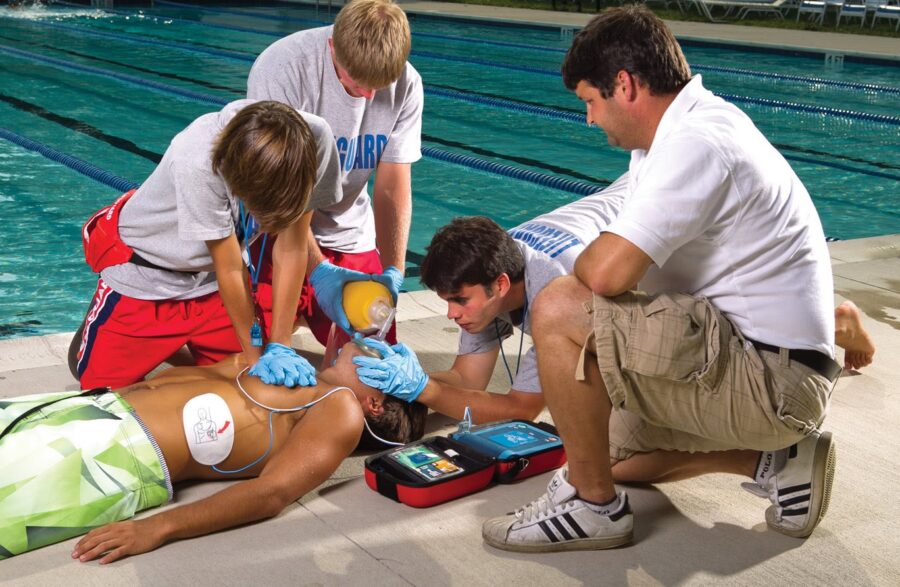In a world full of uncertainties, one component remains constant – the importance of CPR and AED training. Every year, endless lives are taken away. It is because of the fast and decisive moves of individuals who’ve been trained in Cardiopulmonary Resuscitation (CPR) and using Automated External Defibrillators (AEDs) that lives are saved. These life-saving strategies aren’t only for healthcare professionals; they are skills that absolutely everyone can learn and execute at some stage in vital moments. In this blog, we will discover the importance of CPR and AED training, how to become CPR/AED certified, their accessibility, and the impact they have on saving lives.
Understanding CPR and AED
-
What is CPR?
CPR, or Cardiopulmonary Resuscitation, is a life-saving technique used whilst someone’s heartbeat or respiration has stopped. It entails chest compressions and rescue breaths, which help oxygenated blood flow and hold critical organ functions until professional medical assistance arrives.
2. The Role of AEDs
Automated External Defibrillators (AEDs) are transportable devices that deliver an electric shock to the heart in instances of sudden cardiac arrest. These devices can analyze a person’s heart rhythm and, if essential, provide an electric shock to bring back the heartbeat. AEDs are user-pleasant, designed to be operated by people with minimal training.
The Importance of CPR and AED Training
-
Immediate Response Saves Lives
Time is of the essence in cardiac emergencies. Studies have proven that on-the-spot CPR and defibrillation can substantially boost the probability of survival. In truth, for every minute that passes without CPR and defibrillation, the probability of survival is lower by 7-10%. When you are trained in CPR and AED use, you can:
- Be prepared to behave in an emergency.
- Increase the possibilities of survival for those around you.
- Make a wonderful effect on your network’s safety.
2. Bystander Intervention
In many cases, bystanders are the first to reach the scene of a cardiac emergency. Having people educated in CPR and AED use in the network increases the likelihood of an active and powerful response, which could make all the difference in saving a life.
3. Empowerment Through Training
CPR and AED training empower people to come forward in case of emergencies. Knowing what to do and having confidence can have a vast effect on results, reducing panic and potentially saving lives.
Accessibility and Availability
1. Widely Available Training Programs
Many businesses, faculties, and healthcare establishments provide training to the general public. You can enroll in CPR and AED training programs and become a Good Samaritan when the occasion arises.
2. AEDs in Public Spaces
The placement of AEDs in public spaces has come to be extra common in recent years. You can discover AEDs at airports, purchasing department stores, gyms, schools, and other public places. These devices are often accompanied by clear commands to be used, making them on hand to every person, even without previous training.
Steps to Save a Life
1. The Chain of Survival
Understanding the “Chain of Survival” is crucial for effective CPR and AED use:
- Recognition of Emergency: Recognize the symptoms of cardiac arrest, along with loss of cognizance and unresponsiveness.
- Activation of Emergency Services: Call 911 or your local emergency number at once to request professional assistance.
- Start CPR: Begin CPR straight away. Push hard and speedy in the middle of the chest, permitting the chest to rise absolutely among compressions.
- Use an AED: If to be had, use an AED as quickly as feasible. Follow the device’s instructions carefully.
- Early Advanced Care: Ensure that professional medical help arrives to offer advanced care.
2. The Psychological Preparedness
3. Training for Different Age Groups
CPR and AED training may be tailor-made to a one-of-a-kind age business. There are specialized courses available for adults, and youngsters ensuring that you can provide suitable care in various conditions. Here’s what you need to remember:
- CPR and AED education can save lives.
- Bystander intervention is critical.
- Training is widely to be had and on hand.
- Know the ‘Chain of Survival’ steps.
- Act immediately in a cardiac emergency.
4. Maintaining Certification and Skills
To stay effective in CPR and AED utilization, it is critical to keep your capabilities up to date. Explore the importance of certification renewal and continuous training to make certain you’re continually prepared to respond in an emergency.
Conclusion: The Power to Save Lives
CPR and AED training courses are essential skills which could suggest the difference between life and death in a cardiac emergency. These techniques aren’t reserved for healthcare professionals however are handy to everyone. Remember, on the subject of saving lives, every second counts. By recognizing the significance of on-the-spot response and acquiring the essential skills, you could be a hero in someone’s time of need.
Don’t wait—empower yourself with the knowledge and talents needed to make a life-saving difference in your community. Sign up for a CPR and AED training direction and become a Good Samaritan.

